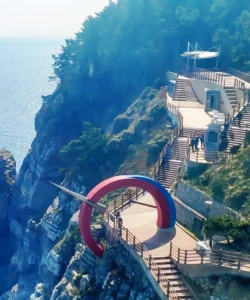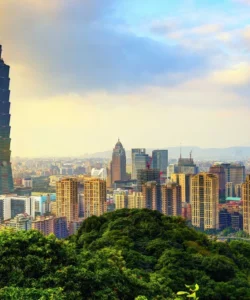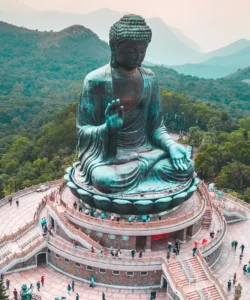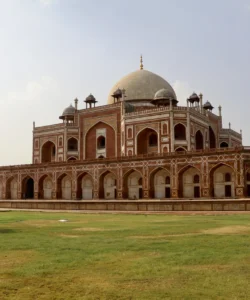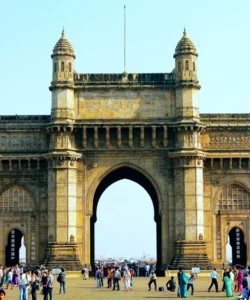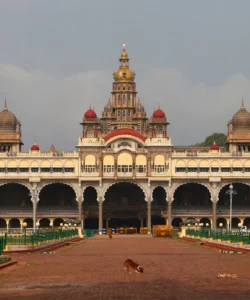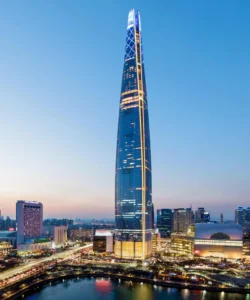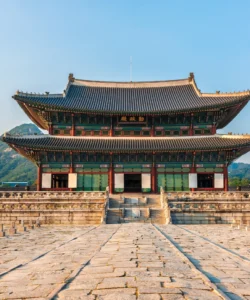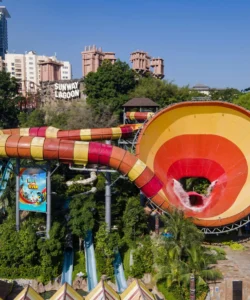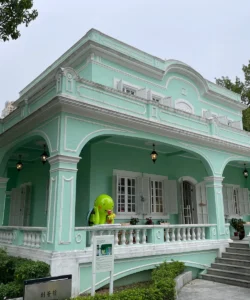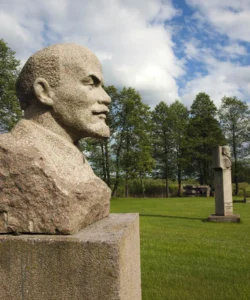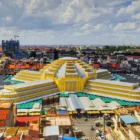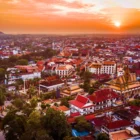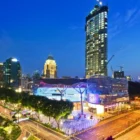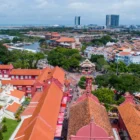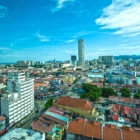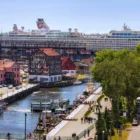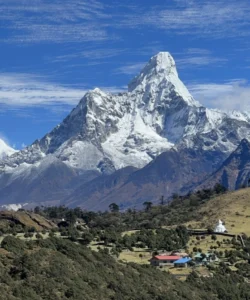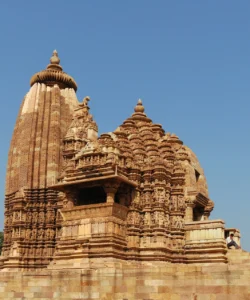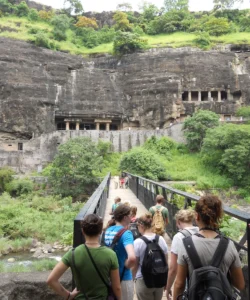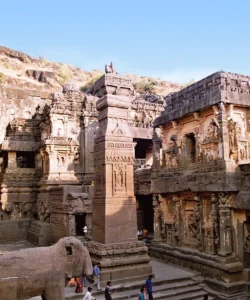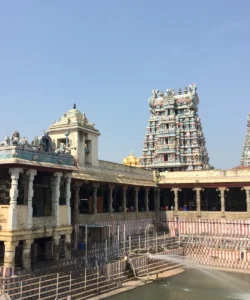The Ajanta Caves are an extraordinary archaeological site in Maharashtra, India, specifically famous for their exquisite rock-cut Buddhist cave monuments. These ancient caves are a treasure trove of Buddhist religious art, renowned globally for their remarkably well-preserved mural paintings and sculptures, providing an invaluable glimpse into ancient Indian life and artistry.
Name: Ajanta Caves
Address: The Ajanta Caves are located in a horseshoe-shaped rock escarpment overlooking the Waghora River, approximately 100 kilometers (62 miles) northeast of Aurangabad, in the state of Maharashtra, India. They are situated in a secluded, dramatic natural setting.
How to Get There:
Aurangabad is the primary gateway city for visiting Ajanta Caves.
- By Air: The closest airport is Aurangabad Airport (IXU). It has direct flights from major Indian cities like Mumbai, Delhi, and Hyderabad. From Aurangabad Airport, you’ll need to hire a taxi or pre-arranged transfer to Ajanta (approx. 2.5 – 3 hours drive).
- By Train: Aurangabad Railway Station (AWB) is well-connected by trains from various cities across India. From the railway station, you’ll need to take a taxi or a combination of local bus/shared taxi to Ajanta.
- By Bus: Buses are available from Aurangabad Central Bus Station to the Ajanta Caves bus stand. From there, you’ll transfer to an MTDC (Maharashtra Tourism Development Corporation) shuttle bus that takes you closer to the caves (private vehicles are generally not allowed right up to the caves).
- By Taxi/Private Car: This is the most recommended way to reach Ajanta from Aurangabad due to the distance. Hiring a full-day taxi is common, often combining it with Ellora Caves and other nearby sites.
- Important Note: The caves are generally open every day except Mondays. It’s best to arrive early in the morning to avoid crowds and the heat, as there is a fair amount of walking involved.
Landscape and Architecture:
The Ajanta Caves’ “architecture” is a magnificent example of rock-cut construction, where entire monasteries and prayer halls were meticulously carved out of a sheer basalt cliff face.
- Horseshoe-Shaped Gorge: The 30 (including unfinished ones) rock-cut caves are dramatically excavated into the vertical, 75-meter (246-foot) high cliff face of a ravine, forming a natural horseshoe shape around the River Waghora. During the monsoon season (June to September), numerous small waterfalls cascade down the cliff, adding to the scenic beauty of the site.
- Exclusively Buddhist: All the caves at Ajanta are Buddhist, built and patronized over several centuries. They represent two distinct phases of Buddhist rock-cut architecture in India:
- Early Buddhist (Hinayana/Theravada Phase): Dating from the 2nd century BCE to 1st century CE (e.g., Caves 9, 10, 12, 13, 15A). These caves are simpler, often emphasizing the stupa (relic mound) as the object of worship and generally lacking figurative representations of Buddha.
- Later Buddhist (Mahayana Phase): Dating from the 5th to 6th century CE (e.g., Caves 1, 2, 16, 17, 19, 26). These caves are grander and feature elaborate statues of Buddha and Bodhisattvas within their shrines and halls, reflecting the evolution of Buddhist thought and artistic expression.
- Chaityas (Prayer Halls) and Viharas (Monasteries): The caves primarily consist of two types of structures:
- Chaityas: Large, vaulted halls with a stupa at the far end, often with aisles for circumambulation. These were designed for congregational worship and meditation.
- Viharas: Multi-celled residential complexes that served as monasteries for Buddhist monks. They typically feature a central hall surrounded by small living cells for sleeping and a shrine chamber with a Buddha statue. Many viharas are multi-storied.
- Mural Paintings (Frescoes): Ajanta is most famous for its exquisite mural paintings that adorn the walls, ceilings, and pillars of many caves (particularly Caves 1, 2, 16, 17). These are considered among the finest surviving examples of ancient Indian art and masterpieces of Buddhist religious art. They depict:
- Jataka Tales: Stories from the previous lives of the Buddha, illustrating Buddhist morality and wisdom.
- Life of Buddha: Key events from Siddhartha Gautama’s life.
- Courtly Life and Daily Scenes: Offering a vivid glimpse into the sophisticated life, fashion, and culture of ancient India.
The paintings use natural mineral pigments and a unique dry-fresco (fresco-secco) technique, making them remarkably preserved for over a millennium despite centuries of abandonment.
- Sculptures: While paintings are the primary draw, the caves also contain numerous beautiful rock-cut sculptures, particularly in the Mahayana caves, depicting Buddha in various poses (e.g., parinirvana Buddha in Cave 26) and Bodhisattvas.
- “Rediscovery”: The caves were abandoned and overgrown by dense jungle for many centuries until they were “rediscovered” by a British officer, Captain John Smith, during a tiger hunting expedition in 1819.
What Makes It Famous:
- UNESCO World Heritage Site: Designated in 1983, Ajanta is globally recognized for its outstanding universal value, particularly for its exceptional masterpieces of Buddhist religious art, especially its expressive and well-preserved paintings.
- Ancient Indian Mural Paintings: It holds some of the finest and most extensive surviving examples of ancient Indian mural paintings from the 2nd century BCE to the 6th century CE. These paintings provide an invaluable visual record of early Buddhist art, aesthetics, and the social life of the Gupta period.
- Buddhist Art and Architecture: It is a profound testament to the flourishing of Buddhist art, philosophy, and monastic life in ancient India, showcasing the evolution of Buddhist thought and iconography through its two distinct phases of construction.
- Remote and Serene Setting: Its dramatic and secluded location in a horseshoe-shaped gorge, carved into the cliff face overlooking a river, provided a tranquil and inspiring environment conducive to monastic life, meditation, and artistic creation, away from secular life.
- Historical Documentation: The detailed paintings offer unique insights into ancient Indian daily life, costumes, hairstyles, jewelry, architecture, and social customs, serving as a rare visual historical document.
- A “Lost” Treasure: Its “rediscovery” after being hidden for centuries by jungle growth adds a layer of romantic and adventurous allure to its history.
Differences from Some Other Wonders:
- Exclusively Buddhist: The most crucial difference from Ellora Caves (which are also rock-cut but feature Hindu, Buddhist, and Jain caves) is that Ajanta is exclusively Buddhist. This singular religious focus shapes its iconography, themes, and architectural types.
- Primary Focus on Paintings: While Ellora is famed for its monolithic sculptures (especially Kailasa Temple), Ajanta’s unique distinction lies in its exceptional and extensive mural paintings. These paintings are its primary artistic highlight and main draw.
- Older and Earlier Phases: Ajanta’s earliest caves date back to the 2nd century BCE, making its initial phase significantly older than Ellora’s earliest caves. It showcases the earlier evolution of Buddhist rock-cut architecture, including its transition from non-figurative to figurative representations of Buddha.
- Secluded Horseshoe Gorge Setting: Its dramatic and somewhat isolated location in a distinct horseshoe-shaped river gorge is a specific landscape feature that sets it apart from the more linear arrangement of Ellora.
- Monastic Retreat Focus: Ajanta was primarily a monastic retreat, particularly important for monks during the monsoon season (vassavasa), fostering an environment for contemplation and artistic expression, rather than a site for multiple active religious communities coexisting as seen in Ellora.
- No Kailasa Temple Equivalent: Ajanta does not have a single, massive monolithic temple carved from top-down like Ellora’s Kailasa Temple (Cave 16). Its grandeur comes from its painted halls and scale of its monastic complexes carved into the rock.
Ajanta Caves Photos:































